Ghormeh Sabzi (Persian Herb Stew)
Soul-warming Ghormeh Sabzi is a Persian herb stew loaded with dried limes, fresh herbs, and spinach, simmered in a pot with chunks of tender beef or lamb and red kidney beans. It’s perfect served with fluffy basmati rice or tahdig, and it is such a warm and cozy bowl of food!
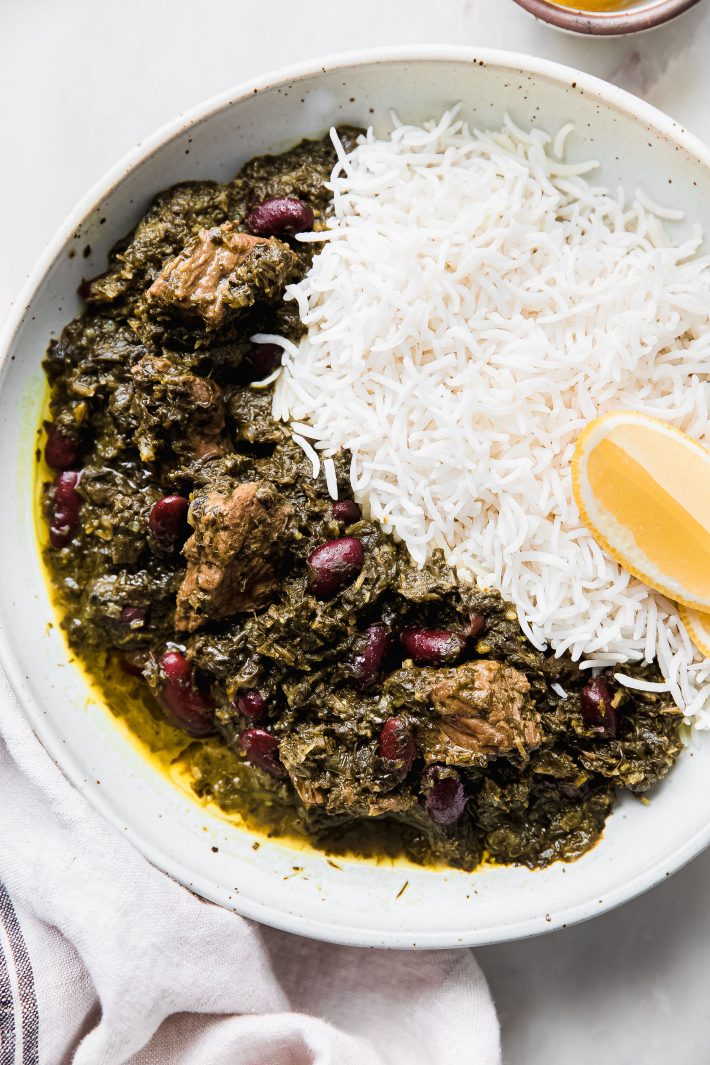
I can’t even tell you how obsessed I am with Ghormeh Sabzi right now.
It is the coziest bowl of greens in a turmeric and dried lime stew with tender chunks of beef and beans. It’s slightly tart from the dried persian limes and lemon juice. The dried limes give the stew the most incredible depth of flavor. The greens are a combination of parsley, garlic chives, fenugreek leaves, cilantro, and baby spinach. And it’s absolutely incredible on a bed of fluffy saffron rice. Though ghormeh sabzi is often made with chunks of lamb, I’m using beef today as it’s much easier to find and tastes good as well.
Personally, I can’t eat ghormeh sabzi or khoresh gheymeh without a bowl of Shirazi salad on the side!
I will say, this is one of those weekend recipes that simmer for a few hours and do require a bit of prepwork. But don’t worry, I’ve got tips on how you can prep some of this ahead of time!
What is ghormeh sabzi?
Ghormeh sabzi is a warm herb stew made with meat and beans. It’s made with a combination of greens, the most common of them being parsley, cilantro, and garlic chives. It is the national dish of Iran. And I consider it the king of Persian stews.
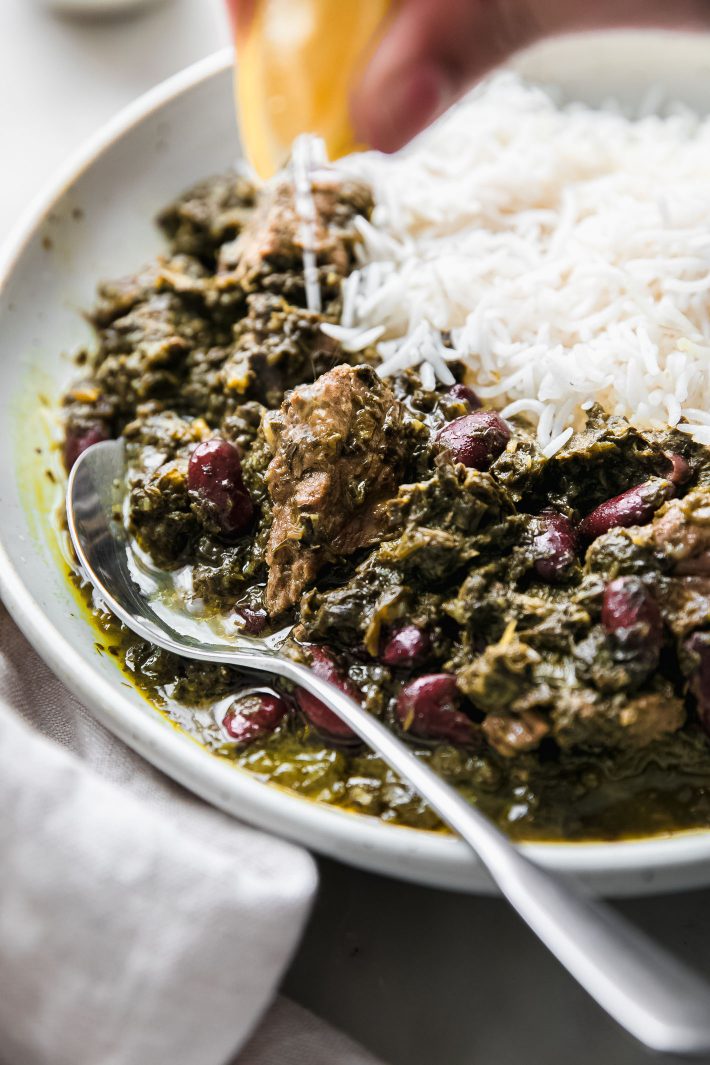
Ingredients for ghormeh sabzi
- Yellow onions: You’ll want to use chopped yellow onions for this recipe. We’ll cook them in the oil until they’re golden brown before searing off the stew meat.
- Olive Oil: You can use ghee, vegetable oil or any other kind of oil you like to use at home for cooking.
- Garlic: You can use as little or as much garlic as you’d like. I usually use around 5 cloves.
- Spices: you’ll of course need salt, turmeric, and black pepper. Though it’s not a spice, you’ll also need a bouillon cube. The bouillon is optional, but it does amp up the flavor of the stock that the meat simmers in. I usually use chicken bouillon, though beef also makes sense.
- Beef: For the meat you want something that can stand up to the long-simmering time this stew requires. I use what my butcher marks as ‘stew meat.’ This is something like a chuck roast or round eye and contains a lot of connective tissue that will break down as the stew gently simmers. Tender chunks of lamb also work. I usually like to have chunks that are about 1½-inch cubes.
- Dried Limes: Also called lemoo amani. These are dried persian limes that give the stew the most delicious depth of flavor. This is one of those ingredients that you’ll find at a middle eastern grocery store for or you can order them online here!
- Herbs, Herbs, Herbs: This stew is a nutrition powerhouse with all the greens! You’ll need a ton of herbs here. You’ll need bunches of parsley and a small bunch cilantro, and then I’ll also use green onions, and dried fenugreek. Fresh fenugreek will also work for this recipe, however, it’s sometimes a pain to clean, and the dried herbs work just as well. The chopping of the herbs takes the longest hands-on time in this recipe. If I know I’m planning on making this, I usually try to wash and dry the herbs a day ahead of time. I’ll even chop the herbs and spinach and box them up for the next day as that cuts down the prep time significantly!
- Baby Spinach: I like to use baby spinach instead of regular spinach. Baby spinach comes cleaned and just requires some chopping. Regular spinach would need to be soaked to get all the dirt and grit out before you dry and chop it.
- Red Kidney Beans: Parts of Iran use kidney beans in their ghormeh sabzi. North and northwest Iran uses black-eyed peas. I’ve even seen people use pinto beans. All this to say that you have a few options here.
- Lemon Juice: Use lemon or fresh lime juice towards the end to cut through the richness of the stew.
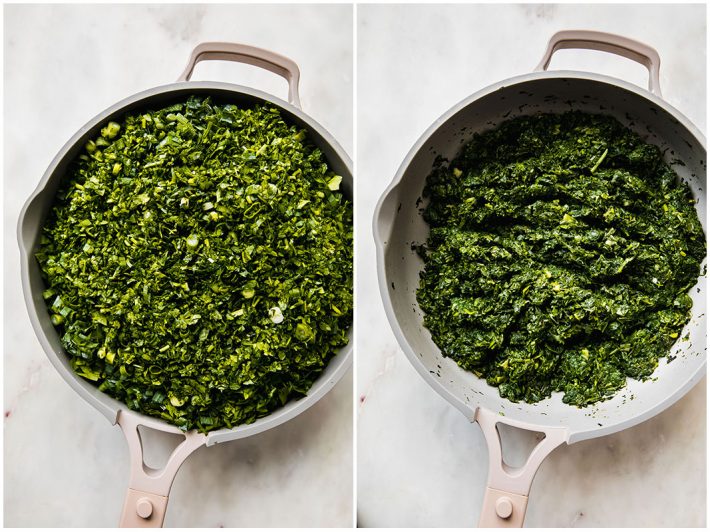
How to make ghormeh sabzi
- Start the stew. In a large pot or dutch oven, add a generous drizzle of oil, and cook the onions over medium heat when it’s hot. Saute the onions until they’re slightly golden. Then add the minced garlic, ground turmeric, and black pepper. When the garlic is fragrant, stir in the meat and let it sear evenly all over. Season the meat with salt, the bouillon cube, and add the water. Bring the stew to a simmer, then lower the heat and simmer uncovered for an hour.
- Simmer simmer simmer. Poke holes in the dried limes with a fork or a paring knife. Then add them to the stew. Cover the pot with a lid but leave a sliver so that the stew vents.
- Saute the herbs. When there’s roughly 20 minutes left. Add a glug of oil to a large skillet or deep saute pan and add the herbs over medium-high heat. Saute the greens until they wilt down to less than half the size. I use dried fenugreek and add that in during the last two minutes.
- Simmer again. Add the greens to the stew along with the drained kidney beans, cover the pot with a sliver to vent and let it simmer again for an hour. The theme here is simmer! The lower and slower you cook this, the more tender the meat and the more flavorful the stew!
- Serve it up. Remove the dried limes and keep them to the side if you plan on serving them with the stew. Check the meat to see if it’s done with a paring knife. If the knife goes through with some resistance, let it simmer for longer until it’s super tender. When the meat is done, add the lemon juice. Taste and adjust with more salt as the stew needs. Then serve it up with tahdig or basmati rice and shirazi salad.

FAQs about this recipe
If you leave the dried limes in the stew for more than a couple of hours, that’s usually the culprit. You want to pull them out after a maximum of 2 hours. Some people like to eat them with ghormeh sabzi. Just remove them once they’re soft and keep them on the side to serve with the stew later.
Yes! You can purchase dried sabzi here. These dried herbs usually contain fenugreek, so you can omit that from the recipe. I would use roughly half the bag and then supplement at least 6 ounces of fresh or frozen spinach. If you decide to use frozen, make sure to defrost and wring out the moisture.
You can clean, dry, and chop the greens all a day in advance. I store them in an airtight container in the refrigerator a day ahead to cut down on the day of prep work.
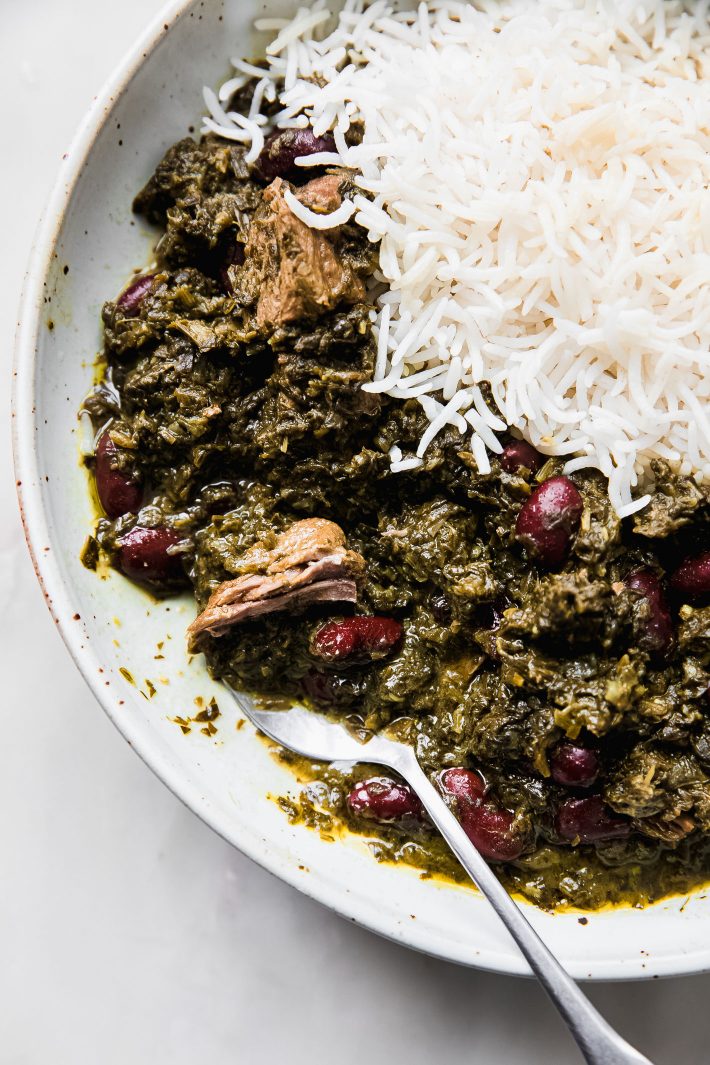
If you like this recipe, you might also like:
- Easy Persian Chicken Kebabs
- Persian Cranberry Rice
- Beef Shawarma Bowls
- Lebanese Meat Pies (Sfeehas)
- Beef Kafta Kebabs
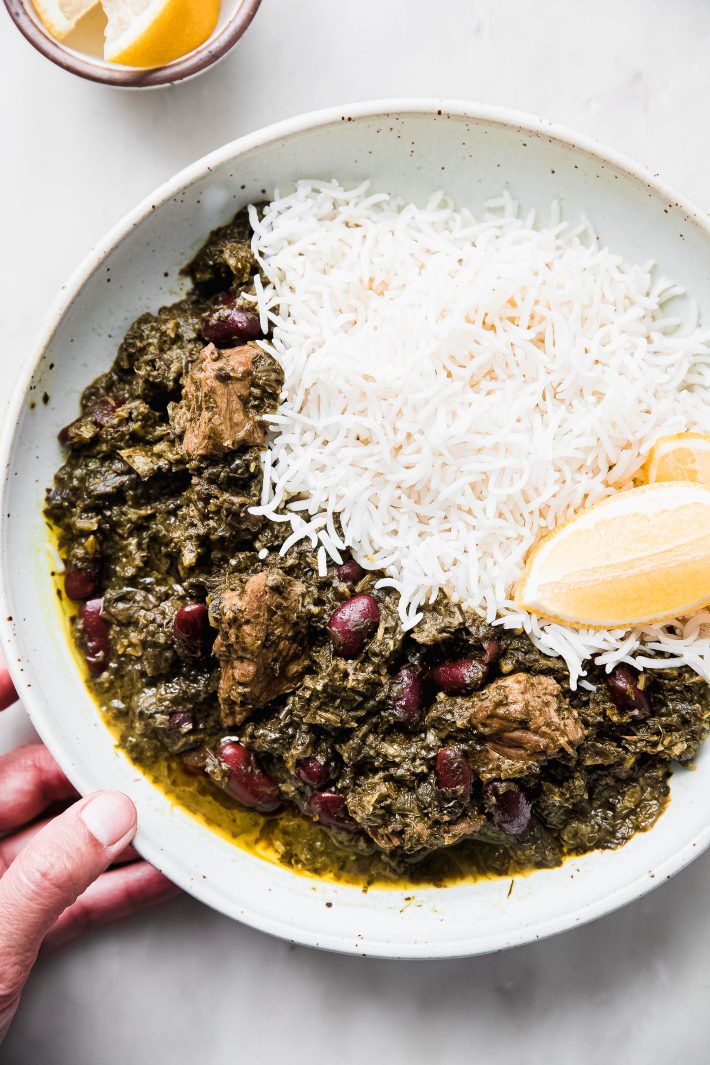
Ghormeh Sabzi (Persian Herb Stew)
Soul-warming Ghormeh Sabzi is a Persian herb stew loaded with dried limes, fresh herbs, and spinach, simmered in a pot with chunks of tender beef or lamb and red kidney beans. It's perfect served with fluffy basmati rice or tahdig, and it is such a warm and cozy bowl of food!
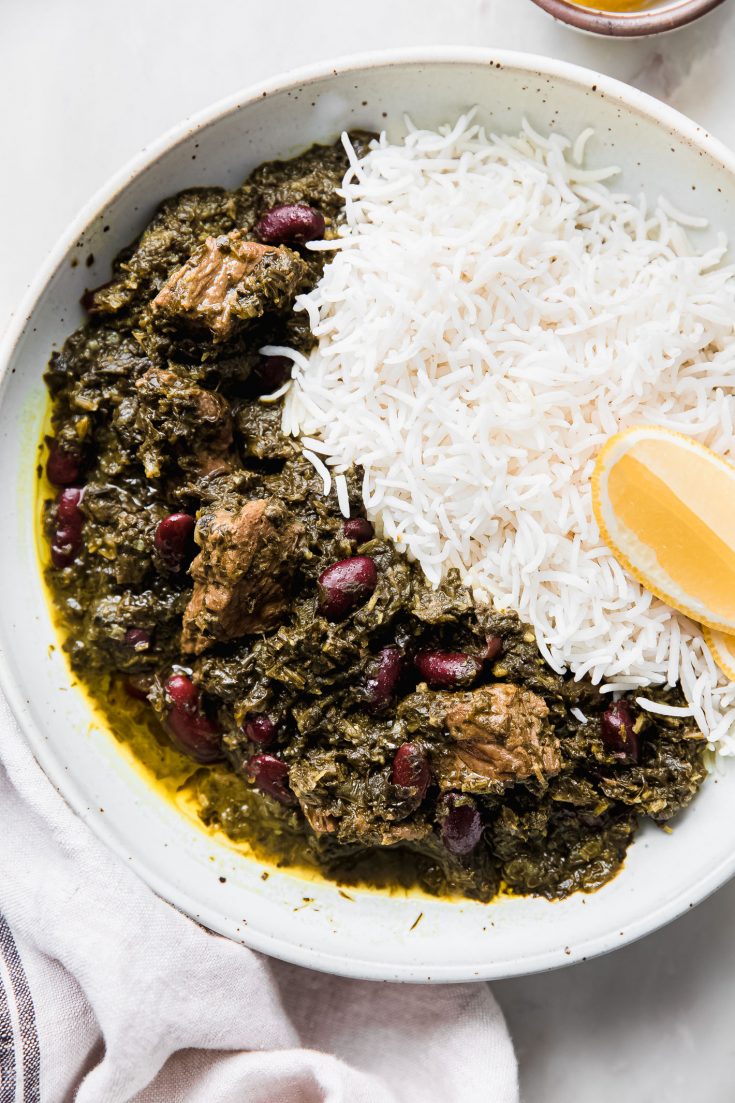
Ingredients
- 1 large yellow onion, chopped
- 6 tablespoons olive oil
- 5 cloves garlic, minced
- 1 teaspoon EACH: kosher salt, ground turmeric AND black pepper
- 1 ½ pounds beef stew meat, in 1½-inch cubes (see notes)
- 1 chicken or beef bouillon cube (optional)
- 4 cups water
- 5 dried limes (lemoo amani)
- 1 bunch cilantro, finely chopped
- 1 ½ bunches parsley, finely chopped
- 12 ounces fresh baby spinach, finely chopped
- 2 bunches green onions, finely chopped
- 2 tablespoons dried fenugreek
- 1 (15 ounce) can red kidney beans (or black eyed peas)
- 1 tablespoon freshly squeezed lemon juice
Instructions
- SAUTE: To a 6-quart dutch oven or larger, add 3 tablespoons of olive oil over medium heat. When hot, add the onions and saute them for 5 minutes. Then add the minced garlic, ground turmeric, and black pepper. Sauté for another 30 seconds before adding in the stew meat.
- BROWN: Brown the meat for 5-7 minutes or until all of the meat is seared on all sides. Season with salt, and add the bouillon cube and 4 cups of water. Kick the heat up to high, bring to a simmer, lower the heat to low, and let simmer for 1 hour, uncovered.
- ADD THE LIMES: Poke holes in the dried limes with a fork or a knife and add them to the meat mixture, stir them in. Cover the pot with a lid, leaving a small sliver to vent, and let simmer for 1 hour.
- SAUTE: When 20 minutes remain, heat a 4-quart pan or larger over medium heat with 3 tablespoons of oil. Saute the herbs, baby spinach, and green onions until most of the moisture is cooked off, and the veggies are vibrant green, about 12-15 minutes. Add the dried fenugreek for the last 2 minutes of cooking.
- SIMMER AGAIN: Add this veggie mixture into the meat mixture along with the drained kidney beans, and stir to combine. If the stew looks a little dry, add ½-1 cup of water, bring to a simmer, and cook for 1 hour, partially covered.
- SERVE: Remove the dried lemons and set aside if you’d like to serve them with the stew, otherwise discard them. Check if the meat is tender and gives easily when pierced with a paring knife, which at this point, it most likely will. If it doesn’t cover and let cook another 30 minutes. If the meat is tender, simmer at medium-low uncovered to thicken the stew for the last 15 minutes. Then add the lemon juice. Taste and adjust with more salt, pepper, and lemon as desired. Serve warm with basmati rice or tahdig and shirazi salad.
Notes
- Stew meat: you can use chuck or round, cut into pieces. Anything that has tough connective tissue that requires a longer cooking time will work well here.
Recommended Products
Nutrition Information:
Yield:
8Serving Size:
⅛thAmount Per Serving: Calories: 350Total Fat: 18gCarbohydrates: 16gFiber: 5gProtein: 35g
The nutrition information is provided as a courtesy and is just an estimate. To get the most accurate information, please input the ingredients you've used into a nutrition calculator.






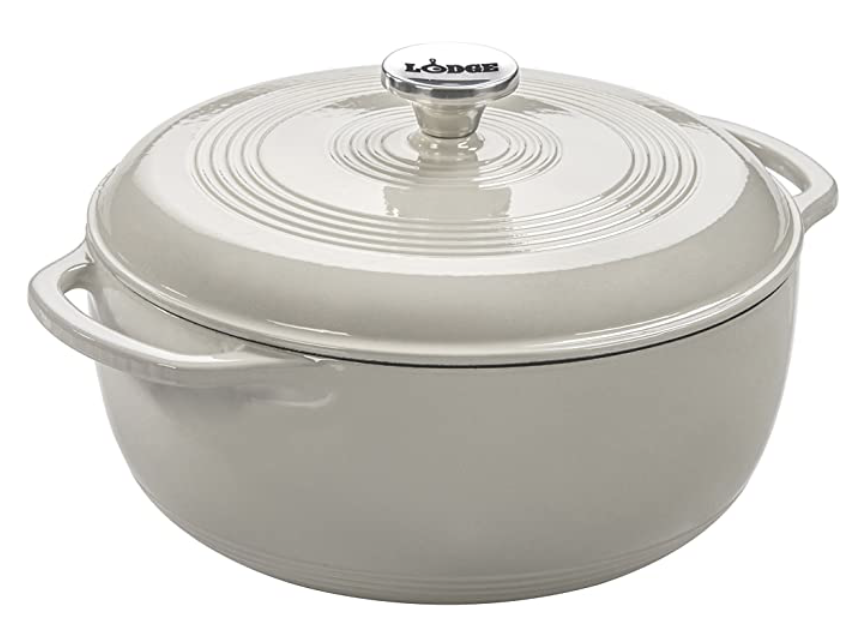

Perfection (as usual with Marzia’s tried and true recipes) I used lamb and followed everything to the letter and it is fantastic. It has a staggering amount of greens (which is what attracted me) I prefer lamb over beef and I used the red kidney beans because that is what my friend said would be the way her family eats it most often. Thank you, thank you this takes a lot of time, but it is worth it!
Hi Lucy! I’m so glad to hear you enjoyed the stew! As always, really appreciate you circling back to leave a review 🙂
Hi , thanks for cooking iranian food but remember this food by staying more on heat will have better taste .
From iranian girl
How to thicken this stew as I used chicken.
Hi, to clarify, you used green onions, not garlic chives, correct? In the article, you mentioned garlic chives twice, but then the recipe listed green onions.
You can use either! Garlic chives aren’t readily available everywhere so the green onions make a somewhat decent sub and that’s why they are listed on the recipe card!
My ML usually uses dried herbs for this. Can you use those with this recipe? If so, does anything need to be modified?
I made a vegetarian version of it last night, using chunks of Seitan instead of the meat and it was delicious! I also cut down on the cooking time since the Seitan didn’t need it, but I did let it simmer a bit to get all the flavour. Looking forward to eating more of it 🙂